Using the correct techniques when performing artificial insemination (AI) can help ensure success while minimizing risk of injury to the technician and the animal. Becoming proficient at performing AI takes adequate training, knowledge, and repetition. Successful AI requires skillfully depositing the semen in the proper location in the female reproductive tract while using sanitary techniques.
Preparation
Before the day of AI, it is important to make sure that all AI equipment and supplies are stocked and ready for use. In addition, make sure that all equipment is cleaned and sanitary. Contaminants such as dirt and manure can be damaging to sperm as well as potentially infectious bacteria into the reproductive tract.
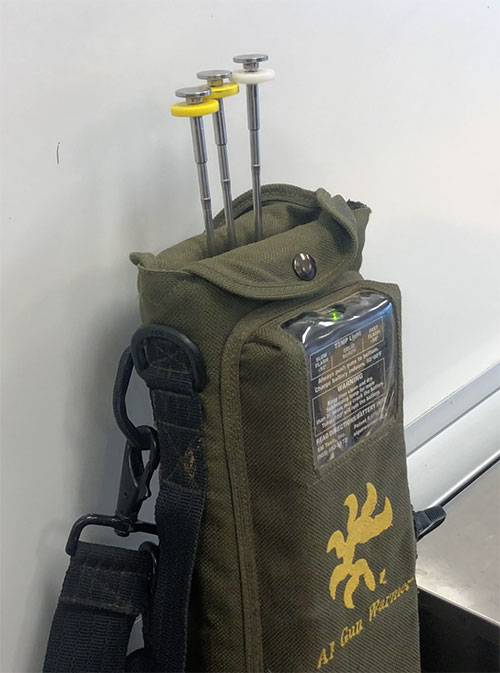
Before putting on a shoulder-length sleeve, wrists and fingers should be free of any item (jewelry, hair ties, watches) that may be abrasive to the rectal lining of the cow or heifer. Place a shoulder-length sleeve on your palpating arm. Most technicians choose to palpate with their non-dominant hand while manipulating the AI catheter with their dominant hand. In addition, some technicians prefer to use an additional latex or nitrile glove on the outside of the sleeve to improve fingertip dexterity. Apply non-spermicidal lubricant to the palpating hand.
The AI process
It is essential to keep the tip of the AI catheter as sanitary as possible in order to reduce the risk of introducing bacteria or other contaminants into the uterus. For a detailed overview of thawing semen and preparing catheters prior to AI, see MU Extension publication G2018, Preparation and Handling of Catheters for Artificial Insemination of Cattle. After loading the straw into the catheter, keep the loaded AI catheter warm and protected, either using an AI catheter warmer (Figure 1) or tucking it into your shirt until it is time to AI. Although completely sterile technique is not necessary or possible, care should be taken to keep the sheath of the loaded catheter clean.
Insertion of palpating arm

Point your fingers and your thumb together (Figure 2) and gently insert your palpating hand into the rectum. With your free hand, use a paper towel to wipe the vulva free of any manure in order to avoid bringing in infectious bacteria. In addition, making a fist and applying downward pressure with your palpating hand will cause the vulva to slightly open, allowing for a clean entrance.
Insertion of the AI catheter
Insert the AI catheter into the vulva at a slight upward 30-degree angle to avoid inserting the catheter into the urethra and into the bladder (Figure 3). If you believe you have inserted into the urethra, pull the catheter back while not completely removing the tip of the catheter from the vagina. It is important to not remove the catheter once you have inserted it in order to prevent contamination of the tip upon removal. Begin to level out the angle of the catheter as you gently push the catheter forward into the reproductive tract.
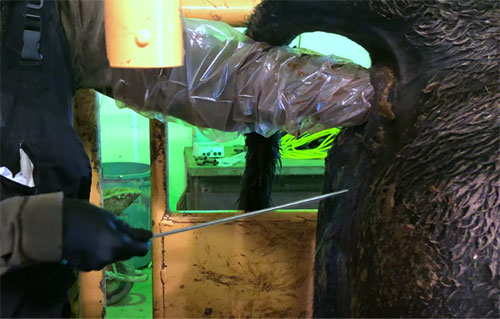
Moving the AI catheter in the tract
It does not take much force to move the AI catheter through the reproductive tract. Avoid applying too much forward pressure with the catheter, as this should be unnecessary and could cause irritation or injury. Vaginal folds will often cause resistance and prevent the catheter from proceeding easily into the tract. If you believe the catheter is stuck in a vaginal fold, manipulate the reproductive tract with your palpating hand as described below while readjusting the direction of the catheter.
Bringing the catheter to the cervix
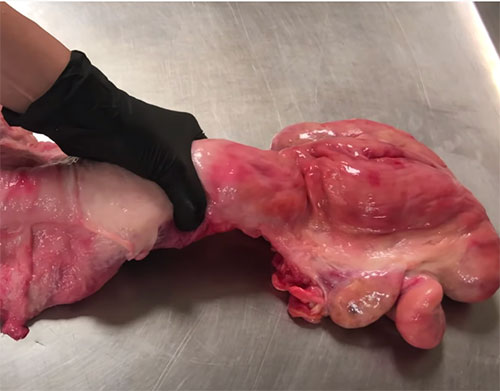
Once you have made progress into the reproductive tract with the AI catheter, palpate the reproductive tract for the cervix. Cervices will vary in size and shape, but all will have the dense feel of connective tissue, distinct from the feel of the vagina or uterus. The cervix is often described as feeling like a “turkey neck.” Keep in mind that heifers will have smaller cervices than mature cows. Bring the tip of the catheter to the opening of the cervix (Figure 4). The catheter may already be in contact with the cervix. If not, take a firm hold of the cervix and push it forward. This straightens out the reproductive tract and eliminates folds in which the catheter may be caught. Gently readjust the depth and direction of the catheter until you can easily guide it to the opening of the cervix.
Inserting the catheter into the cervix
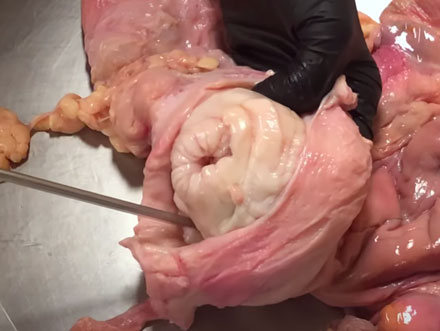
After you have brought the tip of your AI catheter close to the cervix, the next step is to insert the tip of the AI catheter into the opening of the cervix. This is often one of the more challenging steps in the AI process. Around the cervix, the vagina forms a blind-ended pocket called the fornix vagina (Figure 5). It is common for the tip of the catheter to be in the fornix rather than in the opening of the cervix. In addition, the fornix tends to stretch, making the catheter appear to be advancing forward when it could really be above, below or to the side of the cervix. If you feel you are trapped in the fornix, pull the catheter back slightly and use your palpating hand to clamp down around the vaginal end of the cervix. This closes off the fornix and allows your palm and fingers to guide the catheter straight to the opening of the cervix. Due to the cervix being made of dense tissue and cartilage, you will feel a “dragging” sensation to the catheter once the tip is at the opening of the cervix.
Passing the catheter through the annular rings of the cervix
If the cervix is far over the pelvic rim or hard to grip as you try to manipulate it, pull the cervix toward you after the catheter is near the opening of the cervix. You can also press the cervix against the rim of the pelvis to create more support. Once the AI catheter is in the cervix, you will need to pass the catheter through the annular rings. Most cows and heifers will have three to four annular rings. Passing the catheter through the rings can be very challenging in some animals, as the cervix is a tough structure and may require a lot of manipulation.
A key concept is to work the cervix back onto the catheter using your palpating hand, rather than pushing the catheter. After passing through one ring, maintain light forward pressure on the catheter with while you turn and angle the cervix to find the opening to the next ring. It is important to not apply too much pressure, especially if the tip of the catheter is almost through the cervix and close to entering the uterine body. Uterine tissue is very thin and can easily be punctured by the AI catheter if too much force is applied.
Depositing semen in the uterus
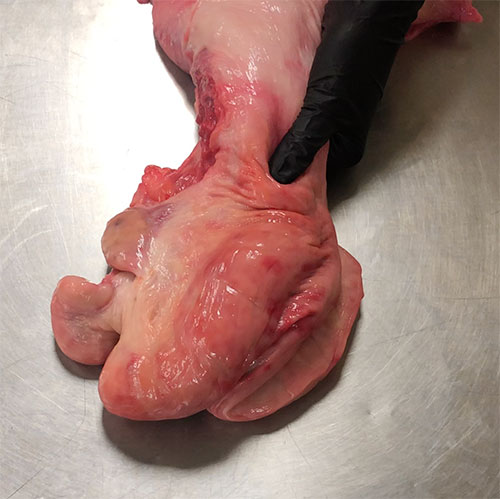
Depositing semen in the correct place is critical. Semen should only be deposited in the uterine body. If semen is deposited in the cervix instead of in the uterus, the vast majority of the sperm cells will actually flow back into the vagina rather than the uterus. To ensure that the AI catheter is in the correct place for depositing the semen, feel for the tip of the catheter with your fingers. If the catheter is still in the cervix, you will not be able to feel the tip of the catheter very well since the cervix is a dense structure. However, if the catheter is through the cervix and in the body of the uterus (Figure 6), you will be able to feel the tip of the catheter through the thin walls of the uterus.
You want to clearly feel about a half inch to an inch of catheter in the body of the uterus. It is critical to avoid pushing the catheter farther into the uterus and down a uterine horn. Be gentle with movement of the catheter once through the cervix, as the uterine lining is very thin and prone to irritation. Once you are confident the tip of the catheter is in the correct location, deposit the semen. This should be done by depositing the semen relatively slowly (e.g., three to five seconds). In addition, keep the catheter in the same place while depositing semen, making sure not to pull back into the cervix until the semen has been deposited.
Summary
Artificial insemination of cattle involves several steps, and considerable skill and experience is required in order to perform AI successfully for large numbers of animals. To gain hands-on experience, it is strongly encouraged to attend an artificial insemination school, such as those offered regionally through University of Missouri Extension. Additionally, while learning and building the strength and skills needed to AI, consider using the services of a skilled veterinarian or a professional technician.